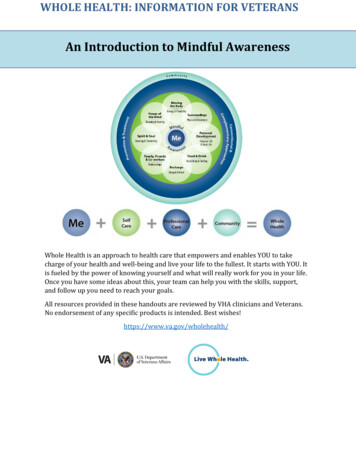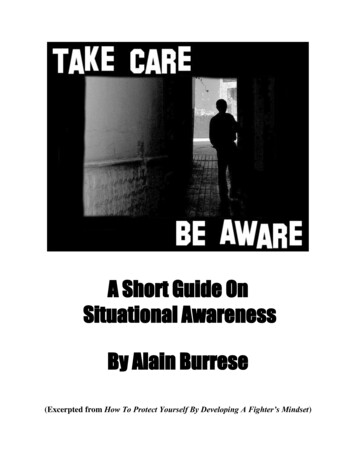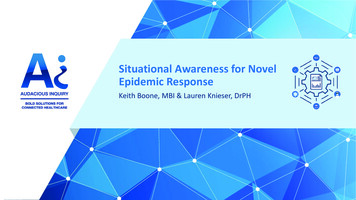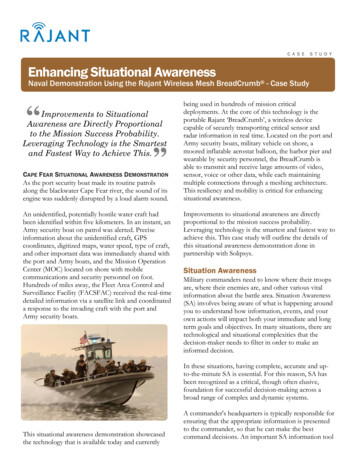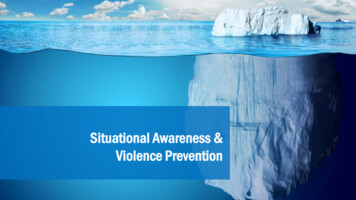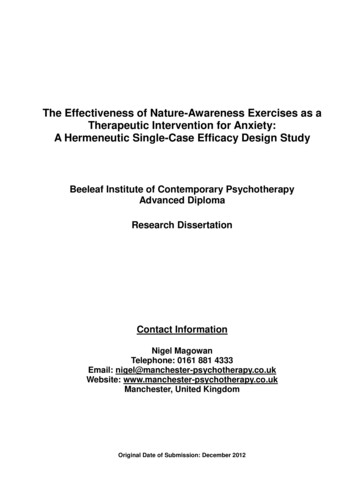
Transcription
The Effectiveness of Nature-Awareness Exercises as aTherapeutic Intervention for Anxiety:A Hermeneutic Single-Case Efficacy Design StudyBeeleaf Institute of Contemporary PsychotherapyAdvanced DiplomaResearch DissertationContact InformationNigel MagowanTelephone: 0161 881 4333Email: nigel@manchester-psychotherapy.co.ukWebsite: www.manchester-psychotherapy.co.ukManchester, United KingdomOriginal Date of Submission: December 2012
Table of ContentsAbstract . 5Literature Review . 6History . 7General Nature Benefits . 7Ecotherapy: Combining Nature with Therapy . 8Wilderness therapy . 9Nature-awareness exercises . 11Natural Awareness Therapy. 12Current research . 12Research Dissertation . 14Introduction. 14Aims of the study . 15Health Benefits of Nature . 15Overview of Nature-Awareness . 16Overview of Natural Awareness Therapy . 17Definition of Contemporary Psychotherapy . 17Overview of Hermeneutic Single Case Efficacy Design . 18The Participant . 19Relevance of Nature-Awareness to Contemporary Psychotherapy . 20Method . 22Methodology . 22Participants . 23Format . 23The Workshop . 24The Exercises . 24The Participant . 24Other Workshop Participants. 25Therapist & Researcher . 26Judges . 26Measures Used . 26Quantitative Outcome Measures . 26Qualitative Assessment . 28HSCED Analysis Procedure . 29Affirmative case . 29Sceptic case . 30Adjudication procedure . 30Variations due to the use of a workshop format . 31Results . 33Quantitative outcome data. 33Qualitative outcome data . 34
Affirmative Brief . 36Sceptic Brief . 38Affirmative rebuttal to the sceptic brief . 39Sceptic rebuttal to affirmative rebuttal . 40Adjudication . 41Summary of opinions about change over course of therapy . 41Summary of opinions about whether change was due to therapy . 41Mediator Factors . 42Moderator Factors . 42Relevance to Contemporary Psychotherapy . 43Discussion . 44Conclusions . 47Recommendations for further research . 48Acknowledgments . 49References . 50Appendix 1: Rich Case Record . 56Section 1: Background/Ethical Issues . 56Confidentiality . 56Consent . 56Therapist competence . 56Context . 56Section 2: The Client. 57Client Descriptions . 57Strengths . 58Medically Relevant Information . 58Medication and Herbal Supplements . 58Previous Experience of Nature-based Therapies . 58Section 4: Quantitative Outcome Data . 59Section 5: Helpful Aspects of Therapy Form Data . 61Summary of the Helpful Aspects of Therapy . 61Summary of the Hindering Aspects of Therapy . 63Section 6: Change Interview Data . 64Helpful and Unhelpful Therapy Process Identified in Follow-Up Change Interview . 66Appendix 2: Affirmative and Sceptic Briefs and Rebuttals . 73Section 1: Affirmative Brief . 73Section 2: The Sceptic Brief. 84Section 3: Affirmative Rebuttal to Sceptic Case . 87Section 4: Sceptic Rebuttal to Affirmative Rebuttal . 90Appendix 3 - Judges Opinions . 92Judge A Opinion. 92Appendix 4 – Description of Nature-Awareness Exercises . 94
Section 1: Overview of Nature-awareness Exercises . 94Section 2: Description of Individual Nature-awareness Exercises . 95Awareness Expansion and Meditation Exercises . 95Sit-Spot . 96Fox Walk . 96Rope Walk (A.k.a. Blind Trail) . 97Tracking Intentions . 97Find a Tree Like Me . 97Drum Stalk . 98Meet a Tree . 98Section 3: Weekend Workshop Timetable . 100Section 4: Exercises completed by the research participant . 101Section 5: Exercises the research participant chose to opt-out of: . 102Appendix 5 – Qualitative Data . 103Section 1: Change Interview Transcript . 103Section 2: Completed Helpful Aspects of Therapy Forms . 121HAT Form 1 – Expanded Awareness Exercises . 121HAT Form 2 – Sit-spot (Morning) . 123HAT Form 3 – Fox Walking. 125HAT Form 4 – Tracking Intentions . 127HAT Form 5 – Sit-spot (Evening) . 129HAT Form 6 – Sit-Spot (Morning). 131HAT Form 7 – Rope Walk . 133HAT Form 8 – Find a Tree Like Me . 135Appendix 6 – Blank Forms . 138Helpful Aspects Of Therapy Form (HAT) . 138Personal Questionnaire Form (PQ) . 140Personal Questionnaire Duration Form (PQ) . 141Simplified Personal Questionnaire Procedure . 142Semi-Structured Change Interview Questions. 144Blank Judge Opinion Form . 146Appendix 7 - General Consent Form and Right to Withdraw . 147Appendix 8 - Consent Form Involving Use of Psychotherapist’s Case Notes . 148Appendix 9 - Participant Letter . 149Appendix 10 - Participant Information Sheet . 150
AbstractHermeneutic Single Case Efficacy Design (HSCED) is a systematic case study researchmethodology for evaluating the efficacy of therapy in a single case. It uses a cross examinationof a variety of quantitative and qualitative data and creates arguments both for and against thecase.It attempts to find evidence that plausibly answers or disproves the questions: Did the clientchange? And did they change as a result of the therapy? An independent judge further evaluatedthe data and arguments.Nature-awareness exercises and games have become very popular with many bushcraft andtracking schools in the UK as a fun way for trainee’s to expand their awareness of nature, anddevelop their sensory skills. The nature-awareness exercises are presented as a series of naturebased games, sensory and awareness exercises, primitive skills, meditations, solo reflective time,and group sharing. They are intended to be fun, and to inspire a playful child-like sense ofwonder towards nature. Whilst at the same time gently challenging the participants to explorebeyond their existing pre-conceptions. Natural Awareness Therapy adds a therapeutic intent tothe existing nature-awareness exercises and games.The author is trained in Contemporary Psychotherapy, which is a solution-focused integrativepsychotherapy.Generalised anxiety is characterised by chronic feelings of excessive worry about a variety oftopics. Individuals can often feel tense and on edge. The worrying feelings are oftenaccompanied by physical symptoms such as racing heart, sweating, tension, shaking and elevatedblood pressure.The study aims to determine if nature-awareness exercises can be an effective therapeuticintervention for adults with an anxiety disorder.A rich case record was collated from the various data sources. Affirmative and sceptic briefs andrebuttals were created and then adjudicated by an independent judge.The judge felt that the client changed considerably, and that the nature-awareness exercisescontributed substantially to the changes.
Literature ReviewA hundred years ago only 2 out of every 10 people in the world lived in a city. Now for the firsttime ever more of the world’s population now lives in urban rather than rural areas (WorldHealth Organisation, 2012). Western society has also become more and more industrialised andurbanised. As of the 1980s people in industrialised nations spend more than 90% of their livesindoors (National Research Council, 1981), our time spent outside is estimated at only 1% - 5%.(Chalquist, 2009) As a modern society we appear to have become increasingly disconnectedfrom the natural world. Ulrich (Ulrich et al, 1991) cites (Cohen et al, 1986), when he writes thatthere is a rapid accumulation of evidence indicating that environmental stressors from urbanliving (e.g. overcrowding, community noise, air pollution) can elicit substantial stress andanxiety in large groups of people. Our bodies have evolved to work in close harmony with thenatural world. This is most evident in the way our bodies synchronise with the natural light anddark cycles of the day, and the longer seasonal cycles (Roberts, 2010). Living and working inartificially lit offices and homes, and spending so little of our time outdoors in natural daylightinterfere with our circadian rhythm which can result in changes to our sleep/wake cycle, bloodpressure, metabolism and immune responses (Roberts, 2010).With environmental issues now having a more prominent political focus, just about everyone inthe western world is aware of environmental crises such as global warming (NCDC 2009).Professor Lovelock who conceived the idea of the Gaia hypothesis (Lovelock, 1972), believes itis already too late to save civilisation as we know it, as the climate may have moved beyond apoint of no return. (Lovelock, 2007) People are being encouraged to recycle, reduce energyconsumption, and live a greener lifestyle. For some people this pressure to live a ‘greener’ lifecoupled with concerns over the future health of the planet is causing what has been coined ‘ecoanxiety’ (Nobel, 2007).Combining environmental stressors from urbanisation, and changes in lifestyle fromindustrialisation, plus the physical and psychological effects of spending less time outdoors, andconcerns over the state of the environment, it is really no wonder that our mental health issuffering. (Evans & Cohen, 1987)
HistoryFor millennia we have existed in very close relationship with the natural world, we have beenintrinsically connected to the rhythms of our natural environment for our water and food and tothe changing of the seasons. The Biophilia Hypothesis (Wilson, 1984) puts forward the idea thathumans have an innate need to be close to nature and living things. It suggests human identityand personal fulfilment depend on our relationship with nature. The human need for nature isnot just linked to use of its resources but it also has an influence on our emotional state, thoughtprocesses and even spiritual development. (Chalquist, 2009) Wilson states that human evolutionis so closely intertwined with our environment that our need for relationship with nature mustreside in our very genes (Wilson, 1984). In their article, Williams and Nesse tell us that ourgenetic make-up has barely changed over the last 10000 years, an almost insignificant change of0.005%. (Williams & Nesse 1991) Therefore it would seem that despite our technologicaladvancements and societies sense that it can survive isolated from nature, we are still geneticallyhard wired to coexist in close relationship with the natural environment. Louv believes thatconflicts can arise between our modern society's disconnection from the natural world and ourinnate need to relate to it. This can create a series of internal behavioural conflicts which maygive rise to dissociative and addictive problems. (Louv, 2005)Given our seemingly in-built requirement for interaction with the natural world for our physicaland mental well-being, it would appear that there is a strong need to research ways of integratingnature back into our therapeutic practices and daily lives.General Nature BenefitsThere is now much research to support the benefits of nature on our general well-being. Severalrecent large studies in Japan involving over 1000 subjects, with control groups in built-upenvironments doing the same activities, have shown that spending time simply walking orcontemplating in a forest setting is associated with lower cortisol levels, lower blood pressure,reduced heart rate and increased heart rate variability. (Park et al, 2010)Research originally conducted by Ulrich (Ulrich, 1979) in which he showed photographs ofnature scenes to students who were about to take an examination, reported a subjective reductionin fear, and a more positive outlook, when compared to those students who were shownphotographs of urban built scenes. Recent research has supported Ulrich’s results (Chang, 2007).Participants were connected to Electroencephalograph (EEG) equipment to measure their brain
wave activity, electromyograph (EMG) to measure muscular tension, and BVP (Blood VolumePulse) to measure sympathetic arousal through changes in blood flow and pulse. Whilst beingshown images of natural scenes in nature, subjects showed higher alpha wave activity anddecreased sympathetic arousal when compared to their non-viewing scores, indicating a greaterstate of relaxation.In a study conducted by MIND (MIND, 2007), 20 members took two walks in contrastingenvironments to test the impact on self-esteem, mood and enjoyment. 44% of participants whowalked through an indoor shopping centre experienced reduced self-esteem. While 90% ofparticipants on a green walk reported increased self-esteem. 71% reported decreased levels ofdepression following the green walk. Whilst 22% reported an increase in depression after thewalk through the shopping centre. 71% said they felt less tense after the green walk, while 50%said their tension had increase after the shopping centre walk.In a study held at a residential care facility, elderly residents performed activities both in aclassroom and in the garden. In the garden environment cortisol levels were significantly lowerindicating reduced stress levels. (Rodiek, 2002)There are a number of studies which show that exposure to natural environments can affectphysical health and recovery from surgery. A view from a window of nature, rather than a builtenvironment speeds recovery after surgery. In a study involving prisoners, those whose cells hada view of a natural environment used less of the health care services, had improved workperformance and increase job satisfaction. (Hartig, Mang & Evans, 1991; Ulrich et al, 1991)Ecotherapy: Combining Nature with TherapyWhen the positive effects of nature are combined with traditional psychotherapy and counsellingmethods carried out by qualified professionals, we get a nature-based therapy which leveragesthe benefits of both worlds. Clinebell originally coined the term 'ecotherapy' (Clinebell 1996).Chalquist describes ecotherapy as “an umbrella term for treatment modalities that include thenatural world in relationships of mutual healing and growth” (Chalquist, 2009). Ecotherapy is arelatively new field of therapy but one which has many ancient roots, as such it draws itsinspiration from both modern and ancient practices. Unlike us, our ancestors would have sawlittle or no separation between themselves and the natural world they lived in. Many nativecultures today still live in a harmonious relationship with nature, interacting with natures
rhythms, to sustain and heal, physically, mentally and spiritually. In native cultures the shamanis in effect the equivalent of western societies doctor, psychotherapist and spiritual guide. Thenature-based healing practices of many native cultures are currently being researched andintegrated with modern therapeutic practices under the umbrella term of ecotherapy (Metzner2009).There are numerous ways that nature-based therapists are bringing the relationship with natureinto the healing process. Such as Animal Assisted Therapy (King, 2007), Pet Assisted Therapy(Roth, 1999), and Equine Assisted Therapy, Horticultural Therapy (Linden, Grut, 2002), andWalking Talking Therapy (Scott, 2003).Researchers working with depressed patients showed that CBT-based psychotherapy carried outin a forest environment produced superior results when compared to the same therapy in ahospital environment. (Kim, Chung & Woo, 2009)In a controlled study, patients diagnosed with schizophrenia, anxiety, affective disorders, andpersonality disorders showed significant improvement in coping ability, self-efficiency, symptomreduction, and quality of life after spending 3 hours twice a week working with farm animals for12 weeks (Berget, Braastad & Ekeberg, 2008).Wilderness therapyWilderness-therapy is an ecotherapy that has been around since the 1960's and uses the naturalenvironment to challenge and help participants (Harper 1995). It evolved from Outward Bound,an adventure programme which was developed in the 1940’s during WW2 by Dr. Hahn, whobelieved that presenting stressful challenges in an outdoor environment would allow seamen tolearn about themselves, build confidence and help bond them as a group. Unlike moretraditional indoor therapies, wilderness therapy often takes place over extended periods of timeand can involve hiking, camping and other outdoor activities. This necessitates a differenttherapeutic relationship with the participants, as you share not just the therapy time with thembut also the day to day living activities.Russell defines wilderness therapy as the use of traditional therapy techniques, especially grouptherapy techniques, in a wilderness setting, when the wilderness is approached with therapeuticintent. Wilderness therapy utilises outdoor adventure pursuits and other activities, such as
primitive skills and reflection, to enhance personal and interpersonal growth. Base-camping andexpedition-based models are employed (Russell, 2000).Wilderness therapy often uses challenges. This may be the general perceived risk that comesfrom being isolated in the wilderness itself, or the challenges may come from activities. Theperceived risk may be emotional, social or physical. Challenges need to provide just enoughperceived risk so that participants will choose to do them, and not so much risk that they willavoid them. A sense of achievement is felt as participants accomplish what they previouslythought was insurmountable. Having the effect of building confidence, trust, and self-esteem.(Chase, 2009)The wilderness environment offers the opportunity for solitude and reflection, and is well suitedto mindfulness and bite sized spans of keeping the mind in the present moment, keeping theattention off past concerns and future worries. Even if this is only transitory, it allows time foranother mental vantage point to develop enabling the participant to see beyond their currentsituation. (Selhub, Logan, 2
Nature-awareness exercises and games have become very popular with many bushcraft and tracking schools in the UK as a fun way for trainee's to expand their awareness of nature, and develop their sensory skills. The nature-awareness exercises are presented as a series of nature-



